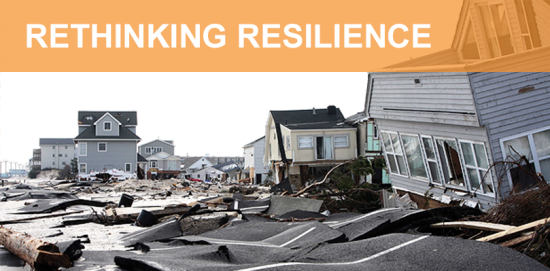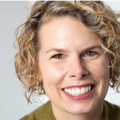At Resilience by Design University, Fundamentals Symposium and Workshop, EPSM Chair Ana Baptista was invited to serve on a panel that invoked not only her work as a tireless fighter for environmental justice, but her background in urban planning. Speaking on “Understanding Challenges and Communicating Responsibilities,” she was joined by Mindy Fullilove, Mailman School of Public Health, Georgeen Theodore, NJIT, and Alan Blumberg, Stevens Institute of Technology.
Resilience by Design University (RBD U) was a two-day symposium and workshop to learn and discuss “how to incorporate concepts and tools for resilience into design… [using] case studies in partnership with 100 Resilient Cities to apply this knowledge in an a series of interactive workshops. The goal of this event: to gain a better understanding of the role design can play in urban resilience.”
The write-up here is reposted from POLITICO and written by David Giambusso.
Design contest leaders seek disaster-minded urban planners.
There are two governing realities that preoccupy the world of urban design in the 21st century: People are moving to cities en masse and those cities are often on the front lines of climate change.
“It’s an urban world and part of the urbanization is it takes places on the edges of the world,” said Henk Ovink, the Netherlands’ special envoy for international water affairs.
His remarks were delivered before a roomful of design, architecture and planning students who will soon be building and rebuilding cities for a planet much different than that of their forebears.
The weekend-long event, held at Columbia’s Graduate School of Architecture and at NYU, was called Resilience by Design University. It is an outgrowth of the Rebuild by Design program — an international design contest launched in the aftermath of Hurricane Sandy to prepare cities for the new normal of chronic flooding, intense storms and rising global temperatures. Practitioners say designing for resiliency in the future will require planners and designers to incorporate a much more diverse set of skills into their profiles.
The contest, sponsored by the U.S. Department of Urban Housing and Development, was focused on New Jersey and New York, but perhaps its most dramatic result was the Big U, a 10-mile barrier that hugs Manhattan from midtown to the Upper Bay. Designed to protect the low lying city from future storms, it also represents a rethinking of the communities most threatened by those storms.
Rather than one monolith, the Big U is a series of compartments — designed for neighborhoods of diverse geography, commerce, and cultures. Its guiding principle is to forge a design for resiliency that emerges from the granular needs and individual identities of each of its components, eventually joining in one giant defense against the next storm.
“What we said with the team was to say we shouldn’t look at this as a big project. What we need to do really is a series of smaller projects, so that it can function on the community level,” said Matthijs Bouw, one of the architects involved with the Big U. “The Big U is not a Big U. It is a series of smaller U’s.”
The designers, scientists, academics and officials that emerged from Rebuild By Design are now taking their collective experience and applying it to cities around the nation and the world, in a program called “100 Resilient Cities,” both funded by the Rockefeller Foundation.
They are developing a curriculum for future planners that reflects the various new roles they will have to play to build neighborhoods that thrive in times of peace and are protected in times of tempest.
Gone, they say, are the days when an official, a planner and an architect could walk into an area and develop its identity from the top down. The planners and designers of the future will have to be as much architect as community advocate and as much research scientist as social scientist. Only in the marriage of those qualities, the group says, will a lasting approach to design take hold that mirrors not only the external threat of climate change but the identities of the threatened.
“We say there is a disconnect between public and private and academia: bullshit,” Ovink said. “We choose to disconnect out of our own disagreements.”
Ovink was tapped by former HUD secretary Shaun Donovan to run the Rebuild by Design contest that tried to embody the holistic approach to designing for the effects of climate change.
The speakers and panelists at the event came from diverse fields and discussed their own research and experience in the push for more inclusive resiliency planning. The greatest challenges and often the greatest environmental threats exist for communities of color, usually poor, that have historically been the victims of planning schemes that served only to perpetuate poverty and segregation.
“We have broken our society over and over again,” said Mindy Fullilove, a professor of clinical psychiatry at Columbia, whose research focuses on the links between environment and mental health.
Cities like Newark and parts of New York are littered with well-intentioned schemes like high-rise public housing or gargantuan highways that continue to drive neighborhoods further into poverty and isolation. They also tend to be areas most affected by pollution, poor infrastructure and extreme weather.
Fullilove and her colleagues at the Friday event said that planners had to start on the streets and community centers of those they were designing for and let their designs emerge from the identities and needs of the communities they served.
“White middle class professionals talk rather glibly about resiliency like its something that you can buy at Whole Foods,” she said. Rather, planners had to be steeped in the institutions, the churches and the businesses that make up a neighborhood.
“Each of these voices is precious in finding our way out, but if they cannot talk to each other, if they are stymied by racism, we are doomed,” she said.
Georgeen Theodore, an associate professor at the New Jersey Institute of Technology’s College of Architecture and Design, discussed the challenges of getting the right people involved in planning for neighborhoods. She worked on a neighborhood plan for the city of Newark and found that community meetings she held were not capturing a broad enough cross section of stakeholders.
“The same group of people came to every single meeting and we felt that we really weren’t getting enough input,” she said. “We’re gathering local knowledge to design a physical space of engagement.”
The typical format of a professional planner standing in front of a microphone explaining design changes for resiliency to local residents was not going to cut it. Ideas had to be represented through art and models and had to be taken outside so people could engage. Theodore conducted surveys, showing people pictures of their own neighborhoods and asking them to write descriptions of what they saw.
“People who live in the neighborhood see it a lot differently than people who plan in the neighborhood,” she said.
Ana Baptista, an assistant professor of environmental policy and sustainability management at the New School, lives in Newark’s East Ward. After Sandy, she said she and her neighbors experienced a sense of fear and isolation as weeks went by returning power to some and clearing out from the storm.
“We cried, we vented and ultimately we organized ourselves,” she said. “With Rebuild by Design we really put the community in the center.”
She cited one primary obstacle to getting more input is that people from poorer communities simply don’t have time to participate.
“If they go to these meetings after three shifts at work they may not see material differences in their lives,” she said.
The new curriculum is being developed over the course of multiple workshops, last weekend being one. The risks and challenges to the holistic approach espoused by the group are manifold. Community outreach and genuine input is messy and inefficient. Politicians often lack will for long-term thinking, community interests can often be at odds with each other, and money to develop projects generally comes with attachments.
The group says without that messy approach, though, any resiliency plans will likely be doomed.
“Why Rebuild by Design was so critical was that designers actually developed the process … We believed in a process that was totally adaptive and changed every day. Why? Because the need was clear,” Ovink said. “But also because there were people — people that were willing to take the risk.”





